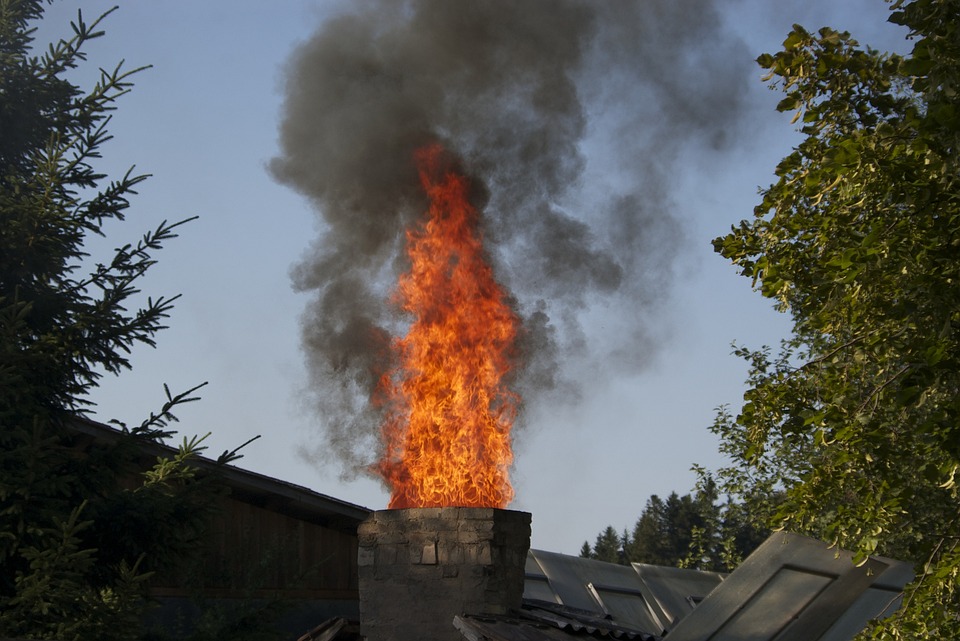Fires that start in chimneys often spread rapidly and tragically. Creosote in the chimney can catch fire and cause the chimney to collapse, even though chimneys are built to resist high temperatures and prevent a fire from spreading to your home. The creosote that accumulates in your chimney is a highly combustible substance. It may easily catch fire in your chimney from a little spark or the heat your stove produces.
Creosote chimney fires may reach temperatures of 2,000 degrees Fahrenheit. In extreme cases, this might lead to the chimney liner cracking and the fire spreading into your house. In such a case, immediately get in touch with a reliable chimney contractor!
What Is Creosote?
Particles of wood, gases, and other chemicals can all be found in smoke from a wood fire. These byproducts of combustion condense upon the chimney walls as they cool while ascending the chimney. Creosote is the result of this condensation.
Creosote is very combustible. There are three stages that it goes through as it accumulates, and removing it gets progressively more difficult as it builds up.
1. Stage One
In the early stages of creosote formation, the substance is flaky and simple to scrape away. With just a chimney brush and some expertise, professionals can get rid of it in no time.
2. Stage Two
Creosote alters the surface over time. The combination becomes thick and hard, eventually resembling glass, making brushing it off impossible. To get rid of the creosote that has advanced to the second stage, you should immediately hire an expert chimney sweep in CT.
3. Stage Three
Stage three of creosote development occurs if creosote continues to accumulate in a chimney. Creosote is so thick and sticky in its final state that it resembles tar. At this stage, it presents the most significant fire hazard. It’s so powerful that you can use it as fuel. When it comes to removing it, professionals typically employ strong chemicals.
When there is too much creosote accumulation, the chimney liner may need to be removed and replaced. Get in touch with your local chimney contractor, for a thorough chimney inspection.
Creosote in a Chimney: What’s the Big Deal?
The buildup of this black, tar-like material on the chimney’s inside walls is a significant source of expensive repairs. Because it contains flammable compounds, it poses a threat if it were to enter your home through the chimney.
Health issues such as asthma attacks, skin irritation, and even cancer have been linked to exposure to these substances.
How to Reduce Creosote Buildup and Avoid Chimney Fires
By adhering to the NFPA’s guidelines, you may stop creosote buildup before it reaches the third stage and causes a chimney fire.
· Use Only Dry, Seasoned Wood For Fires
Having just been cut down, wood is full of moisture, making it harder to burn and creating a thick, black smoke full of combustion byproducts. Seasoned firewood, or wood that has been dried for at least six months, burns cleaner and produces less smoke.
· Build Clean, Efficient Fires
An efficient, cleaner fire can be achieved by stacking firewood, so air can flow between the logs. Making fires in this manner regularly can reduce the amount of creosote in your chimney since the flames will be more efficient.
· Ensure The Fire Gets Enough Air
Before lighting a fire, ensure it will get adequate air by opening the damper. To allow air to flow, you should leave any glass doors on your fireplace slightly ajar.
· Warm Up The Flue
Flue temperatures might drop significantly if your chimney isn’t properly insulated. Condensation and increased creosote deposits can be caused by lighting a fire in a cold chimney. Simply folding up some newspaper to form a torch, lighting it, and holding it up the chimney is a simple way to get the chimney nice and toasty. You’ll know the flue is at the right temperature when the smoke from the flame rises straight up.
· Chimney Cleaning And Inspection
The National Fire Protection Association (NFPA) advises that having your chimney inspected and cleaned once a year is your best defense against chimney fires. Chimney sweeps have specialized training to identify problems that might raise the danger of a chimney fire or creosote accumulation. They’ve got the equipment and expertise to eliminate creosote without causing harm.

When a chimney seems to be malfunctioning, it’s time to call in the professionals. A certified chimney sweep can eliminate the dangerous creosote accumulation in your chimney.
If you follow these steps, you can reduce the risk of a chimney fire in your house. Creative Masonry and Chimney is the company to call if you need trustworthy chimney experts. They provide various chimney services in Simsbury, CT, and other areas. If you’re looking for an experienced masonry contractor in CT, they can help you will that too.


